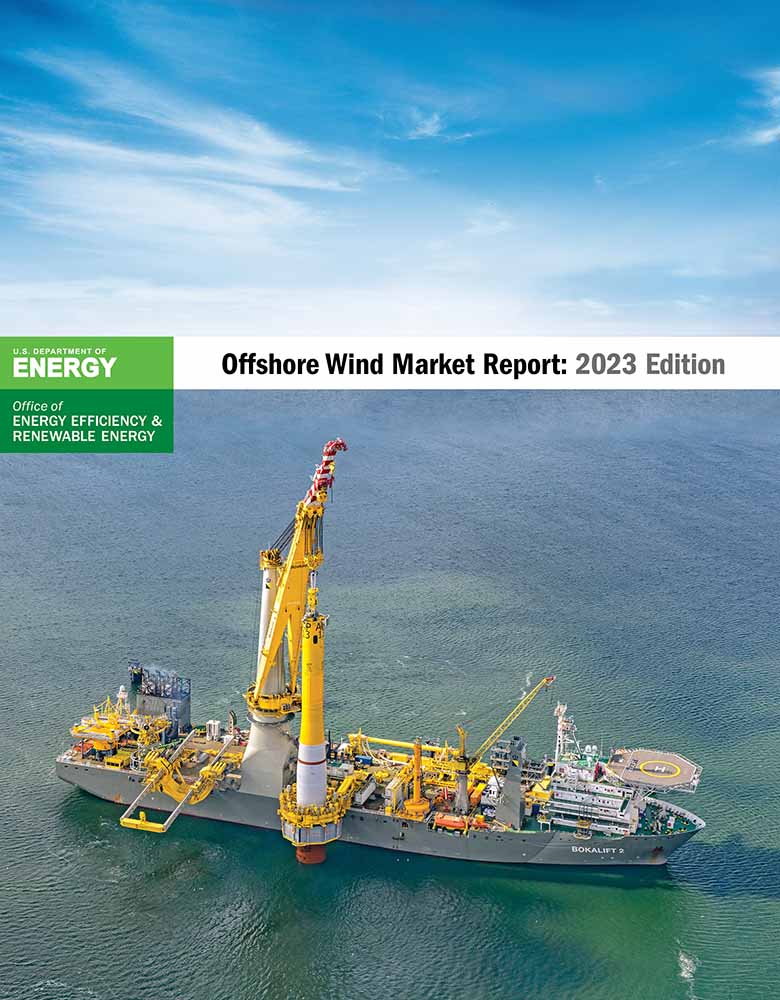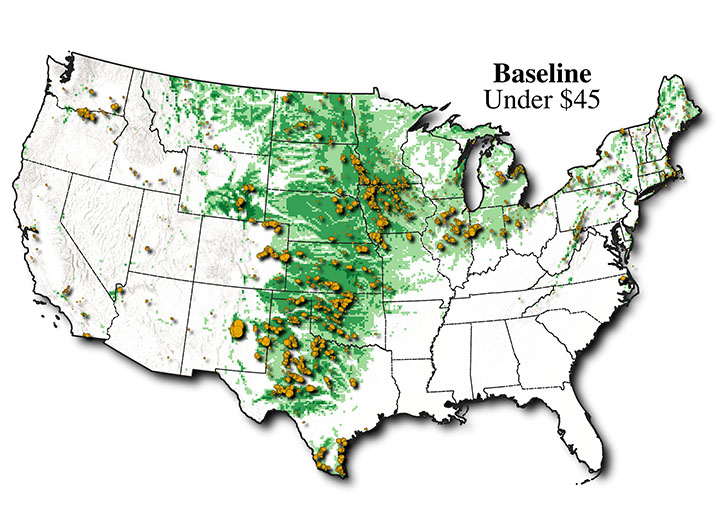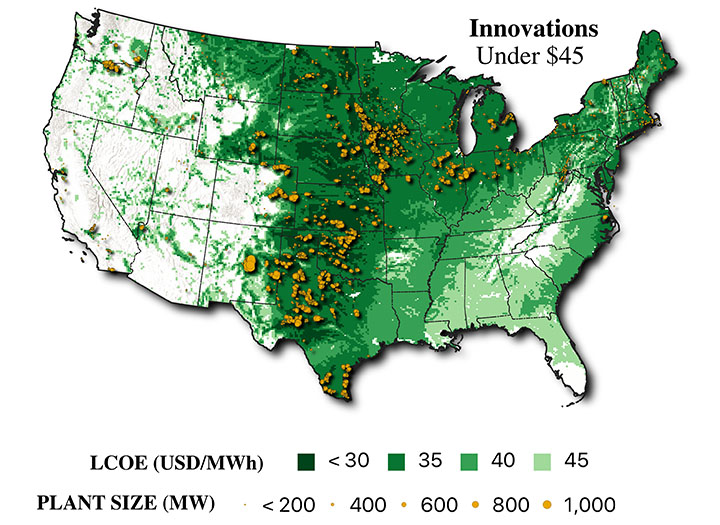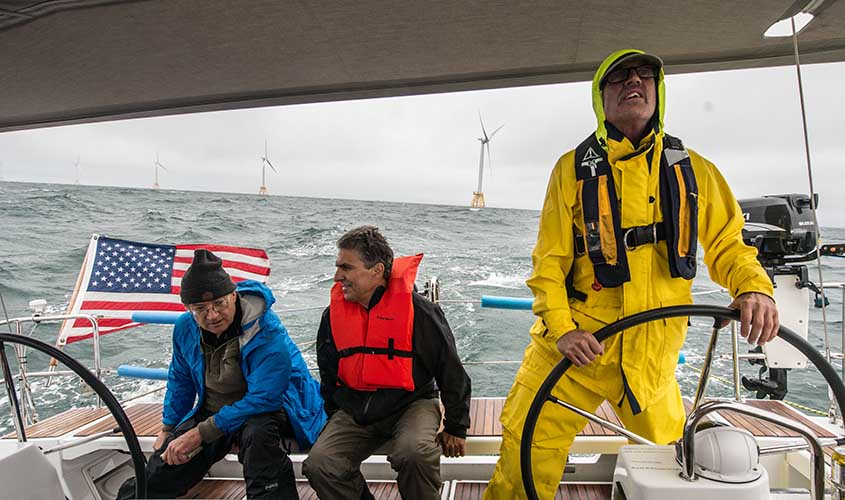The Leading Edge: September 2023 Wind Energy Newsletter
In this issue, NREL shares insights on the offshore wind energy market, wind turbines in areas with low wind, updates on West Coast ports—plus the latest news, opportunities, and publications.
News Stories

Offshore Wind Energy Is Poised To Become a Major Electricity Source
The U.S. offshore wind energy project development and operational pipeline reached a potential generating capacity of 52,687 MW at the end of May 2023, according to NREL's latest annual offshore wind analysis, released by the U.S. Department of Energy's (DOE’s) Wind Energy Technologies Office in the Offshore Wind Market Report: 2023 Edition. The report includes data for the U.S. industry and market from Jan. 1, 2022 to May 31, 2023, and worldwide from Jan. 1 to Dec. 31, 2023. If fully developed, the projects in the U.S. pipeline would be enough to power more than 18 million American homes.
Technology Advancements Could Unlock 80% More Wind Energy Potential During This Decade
In a recent NREL study, researchers found that technology innovations making their way into commercial markets today and in coming years could unlock 80% more economically viable wind energy capacity within the contiguous United States, mostly in regions with little to no existing wind farms, including the East Coast, Southeast, and Gulf Coast. These areas are close to electrical demand centers, potentially reducing the need for new transmission to deploy wind energy at the scale needed to meet local and national renewable energy goals.


An NREL study has revealed that technology innovations could unlock an additional 80% economically viable wind energy capacity as soon as 2025. Innovations in wind technology—such as on-site manufacturing, taller towers, longer blades, and wake steering—could allow wind power plants (yellow circles on maps) to be deployed in new areas of the United States (shaded regions in second map) compared with areas that are viable with current technology (shaded regions in first map). Graphic by Travis Williams, NREL, using the U.S. Geological Survey's U.S. Wind Turbine Database
Behind the Blades
Surfing the Waves of Offshore Wind Energy
This month, several of our offshore wind energy researchers published their efforts to summarize the state of the offshore wind energy industry, both in the United States and globally. With the 2023 edition live, we asked the report's primary author, Walt Musial, NREL's offshore wind energy research and development lead, to tell us about his career, work, and dreams.

How did you become interested in renewable energy/wind energy?
I got interested in renewable energy when I was in high school because of the Arab Oil Embargo and the national urgency to find alternative energy solutions. I started studying mechanical engineering at the University of Massachusetts in 1976, and by pure luck, I stumbled onto their Energy Option program, which was an in-depth engineering curriculum focused on energy systems with core classes in wind, solar, energy efficiency, and other energy topics. I was taken in by renewable energy engineering and stayed on to get my master’s degree in mechanical engineering, focusing on wind energy.
What made you want to work at NREL and in wind energy?
I wanted to work for the broader wind energy industry and help advance the state of the art of the technology, so I left a good job in California working for the world's largest wind turbine manufacturer and developer, where I provided engineering and field test support for over 4,000 wind turbines.
I take pride in the epic wind energy journey we have been on. I have been working on wind energy since the late 1970s, when the technology was experimental and very small scale, to the present day, when we now consider wind energy an essential and major part of our present and future energy supply.
I am motivated to work on technology solutions that have the potential to have a major impact on the transition to a clean energy economy, and I believe I am getting pretty good at filtering out solutions that may not have a high impact.
I enjoy following my instincts to align NREL's research mission with the offshore wind industry's needs and the dozens of collaborations with our external partners, who are working with us to decarbonize our energy supply.
How long have you been at the lab?
I just had my 35th anniversary at NREL.
What areas of research have you focused on at NREL?
- I started at NREL working on our famous unsteady aerodynamics experiment as a test engineer where we revealed some of the fundamental physics governing the behavior of wind turbine operation.
- In the early 1990s, I developed NREL's structural blade testing facilities and upgraded them while we verified the strength and properties of over 100 blades that helped enable the commercial industry to emerge.
- In 1999, I also developed and commissioned the world’s first full-scale drivetrain test facility at NREL, which was later replicated by several countries around the world.
- In 2003, I started the offshore wind research program at NREL, and in 2008, with Bob Thresher, we started the water power research program.
- My current focus is almost entirely offshore wind.

How are you helping develop offshore wind energy?
In offshore wind, we are developing regional technology to adapt to the frontiers such as deep water, hurricane-prone regions, and ice climates (such as the Great Lakes) because, I believe, to achieve global solutions to climate change and meet our long-term clean energy goals, we must expand the feasible resource areas and create new markets.
To stay relevant and anticipate the long-term technology needs of the offshore wind energy industry each year, we are commissioned by DOE to write an annual market report that details industry progress, including technology and cost trends. The 2023 edition was recently published by DOE.
What are your hopes for the future of wind energy?
I envision that, someday, we will be able to harness the vast wind resources of the high seas with roaming untethered wind turbines.
The urgency to quickly decarbonize our atmosphere is comparable to the space race of my childhood days that sought to put a man on the moon before 1970, but stabilizing our climate is much more important than the moonshot. Most young people already know this, but they need to be empowered.
I want to recognize the hundreds of mentors I have had over my career, but there are too many to name. I have always been able to learn new ideas, technologies, and disciplines best, not from textbooks, but from working shoulder to shoulder with the smartest people in the field; many are here at NREL, many others are my gurus outside NREL that I confide in.
On the Radar
What Will It Take To Unlock U.S. Floating Offshore Wind Energy?
A massive 2.8 terawatts of energy potential—enough to power 350 million homes—could be captured off the U.S. coasts with floating wind turbines. To deploy commercial-scale floating offshore wind energy development, the United States will have to develop ports. An NREL study, recently published in a report titled The Impacts of Developing a Port Network for Floating Offshore Wind on the West Coast of the United States, focuses on what it will take for the country to develop a system of ports. That includes the $5 billion–$10 billion to develop the installation and maintenance ports needed to build and operate 25–55 GW of floating offshore wind energy on the West Coast and at least another $10 billion to build manufacturing ports to support a local domestic supply chain that will need to be coordinated by California, Oregon, and Washington.
Turbine Drivetrain Innovations Can Boost Offshore Wind Power and Cut Costs
New studies leveraging conceptual designs of offshore wind turbines point to how wind turbine drivetrains could soon change to produce more power while lowering costs, according to a new journal article by NREL and General Electric Research. In the article, published in Applied Energy, the team detailed how it designed conceptual offshore wind turbines to provide the fairest comparison among drivetrain technologies. Using the NREL-developed Wind Plant Integrated Systems Design and Engineering Model, the team designed three drivetrain technologies across varying power levels for both fixed-bottom and floating foundations. The team found that a medium-speed gearbox coupled with a permanent-magnet synchronous generator exhibited the lowest levelized cost of energy, making it a potential cost-effective solution.
Downwind: In Case You Missed It
New Resource To Help Standardize Safety Training of Offshore Wind Energy Workforce
To meet the nation's goal of deploying 30 GW of offshore wind energy by 2030, the industry will need a robust and well-trained workforce—which needs to be kept safe as a priority. NREL researchers have developed an offshore wind energy workforce safety and training resource, posted on the DOE Wind Energy Technologies Office's WINDExchange website, to help clarify jurisdictions, roles, and responsibilities and identify key actions and partnerships to establish safety training and workforce development. The webpage addresses requirements for vessel-specific safety training, constructing wind turbines, operating and repairing offshore wind turbines, and onshore health, safety, and environment training, which are relevant to, for example, vessel operators, crane operators, engineers, and technicians. The team plans to add information on best practices for offshore wind energy workforce development and supply chain manufacturing workforce development in the coming months.
Upcoming Events, News Mentions, Recent Publications
Upcoming Events
Join NREL researchers presenting at, moderating, or hosting these upcoming events:
American Floating Offshore Wind Technical Summit
Sept. 26–27, 2023, Portland, Maine
Offshore WINDPOWER Conference and Exhibition
Oct. 3–4, 2023, Boston, Massachusetts
NAWEA/WindTech 2023 Conference
Oct. 30–Nov. 1, 2023, Denver, Colorado
Webinar Series: Compensatory Mitigation for Land-Based Wind Energy: Funding Mechanisms
Oct. 2, 2023, 4–5 p.m. ET, Virtual
Webinar Series: Compensatory Mitigation for Land-Based Wind Energy: Grouse Management
and Conservation
Oct. 20, 2023, 2–3 p.m. ET, Virtual
NREL in the News
NREL Study Compares Efficiency of Wind Turbine Drivetrain Technologies, Nina Korman, North American WindPower, Aug. 22, 2023
Mapping Clean Energy in the West, Claire Lang-Ree, Natural Resources Defense Council, Aug. 31, 2023
Wyoming Could Reap More Than $7 Billion if It Takes Full Advantage of the IRA but There Are Many Challenges, Kamila Kudelska, Wyoming Public Radio, Sept. 1, 2023
First Vineyard Wind Turbine Heads out to Sea, Jason Graziadei, Nantucket Current, Sept. 7, 2023
Midwest Taps Dueling Strategies To Supercharge Renewables, Jeffrey Tomich, E&E News, Sept. 18, 2023
Recent Publications
Analysis
Effect of the Integral Length Scales of Turbulent Inflows on Wind Turbine Loads, Renewable Energy (2023)
Materials Used in U.S. Wind Energy Technologies: Quantities and Availability for Two Future Scenarios, NREL Technical Report (2023)
Offshore Wind Market Report: 2023 Edition, DOE Technical Report (2023)
Renewable Energy Materials Properties Database: Summary, NREL Technical Report (2023)
Sensitivity Analysis of Modal Parameters of a Jacket Offshore Wind Turbine to Operational Conditions, Journal of Marine Science and Engineering (2023)
Modeling
Sensitivity of Near-Surface Variables in the RUC Land Surface Model in the Weather Research and Forecasting Model, NREL Technical Report (2023)
Technology
Distributed Embedded Energy Converter Technologies for Marine Renewable Energy: A Technical Report, NREL Technical Report (2023)
Large Castings for Wind Turbines, NREL Technical Report (2023)
PacWave Anchoring and Mooring Study, NREL Technical Report (2023)
Using Large-Scale Additive Manufacturing for Wind Turbine Blade Core Structures, NREL Technical Report (2023)
Wildlife
U.S. Offshore Wind Energy Noise Reduction Questionnaire Results and Recommendations, Tethys Technical Report (2023)
Want More?
Subscribe to The Leading Edge newsletter, and explore the latest news and accomplishments in wind energy at NREL.
Share

